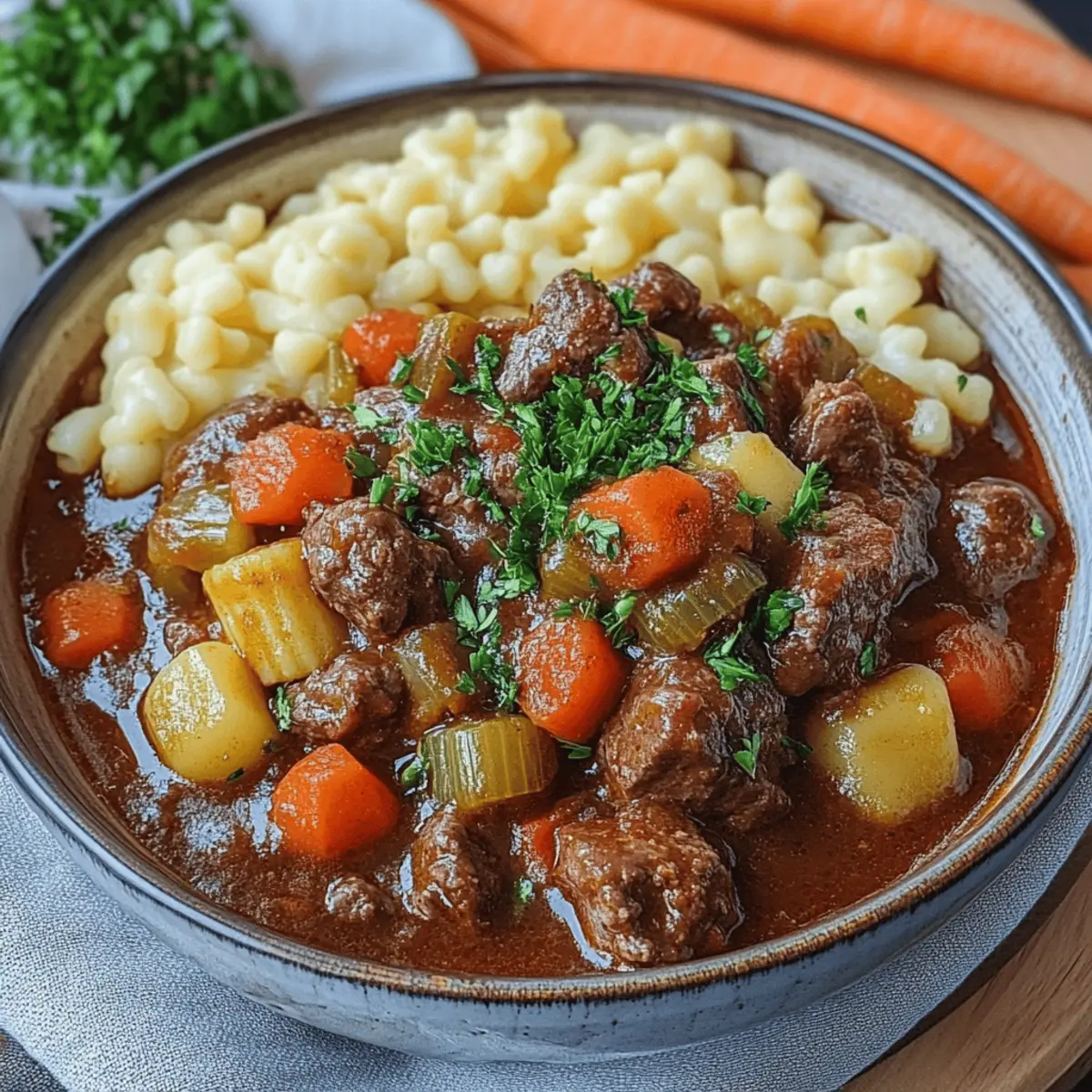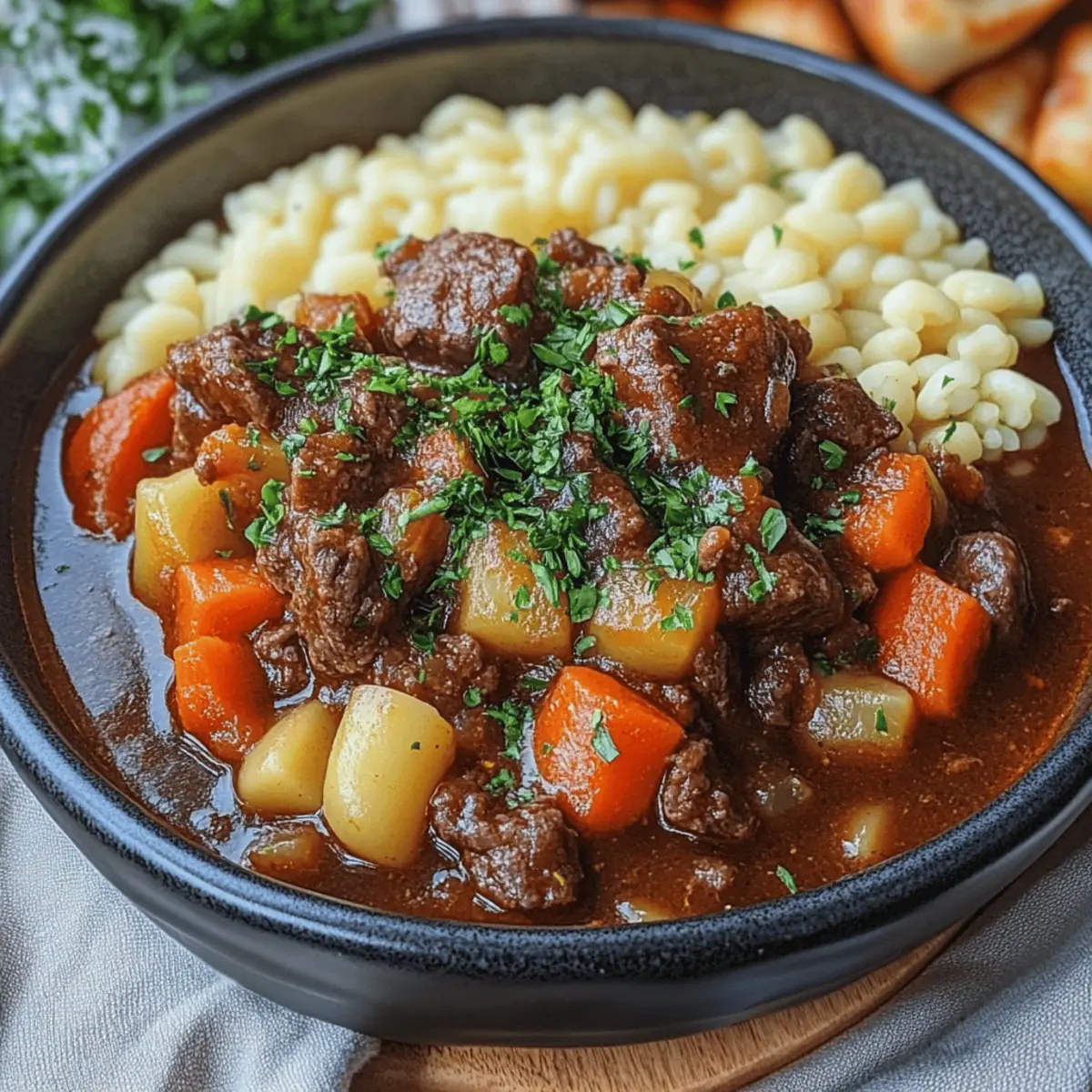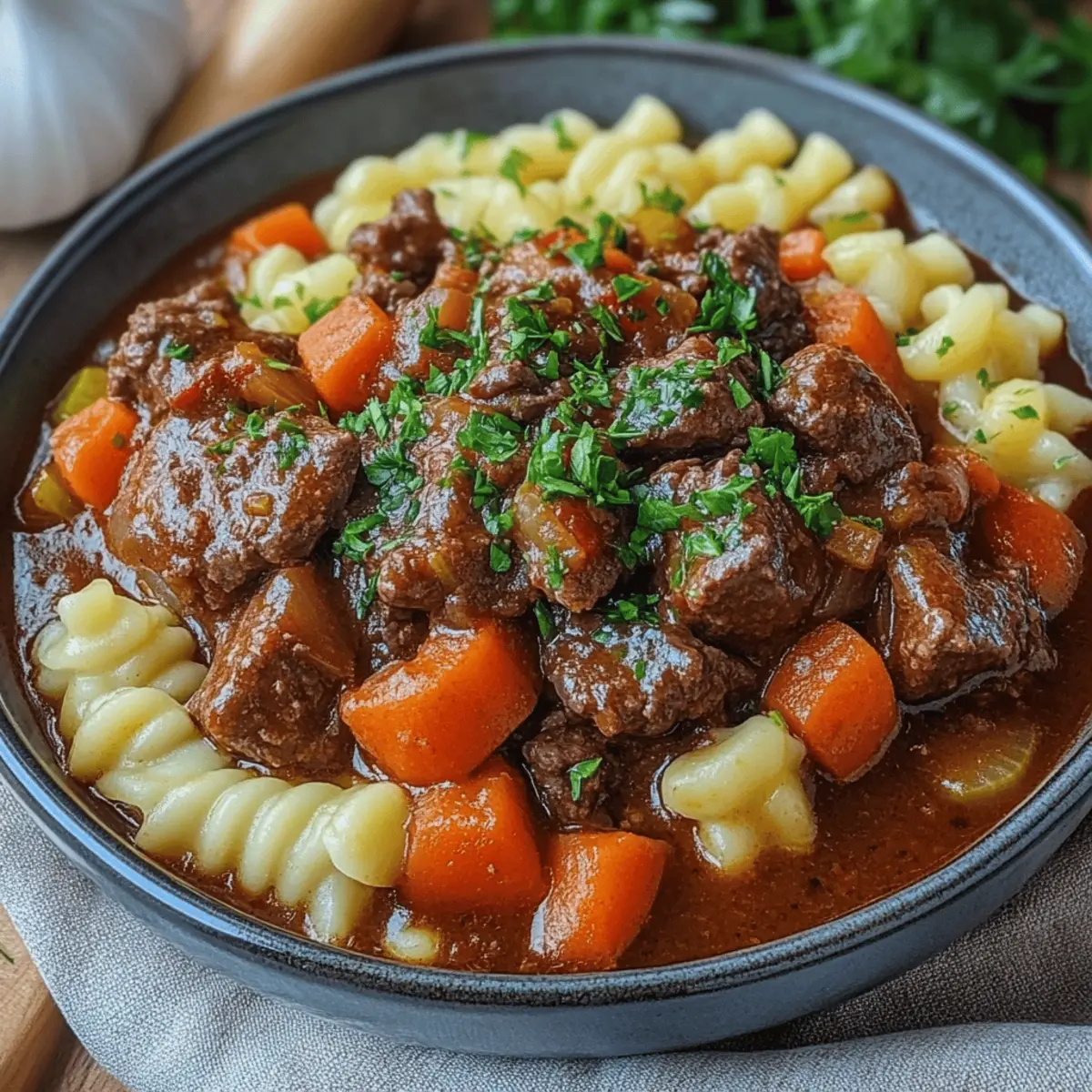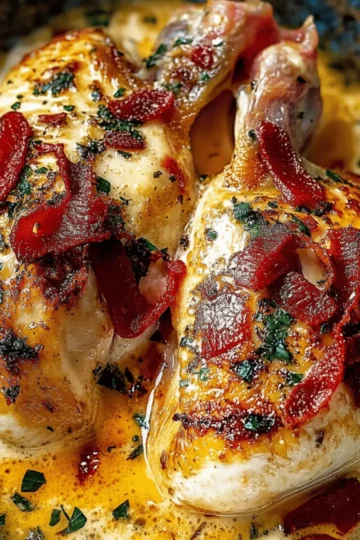As the sun dipped below the horizon, the savory scent of paprika and tender beef wafted through my kitchen, instantly transporting me to a rustic German tavern. This is the magic of my Authentic German Goulash—an embrace of warmth perfect for chilly evenings or lively family gatherings. Not only is this hearty stew a feast for the senses, but it also offers a simple, yet satisfying cooking experience that even the busiest home chefs will appreciate. With every simmering moment, the flavors deepen, allowing you to create a dish that is sure to please everyone at your table. Ready to dive into the world of comforting, homemade goodness? Let’s explore how to make this soul-soothing stew together!

Why is German Goulash a must-try?
Warmth and Tradition: German Goulash brings a taste of rustic tradition straight to your kitchen, offering comfort in every spoonful.
Rich, Flavorful Stew: The combination of sweet and smoked paprika elevates the dish to new depths, enveloping tender beef and vegetables in a fragrant embrace.
Simple Preparation: With straightforward cooking steps, even the busiest home chefs can create this beloved dish without stress.
Versatile Options: Feel free to adapt ingredients—add root veggies or swap in lentils for a vegetarian twist! For more recipes, check out our hearty comfort food ideas.
Crowd-pleaser: Perfect for family dinners or gatherings, this stew is sure to impress and satisfy all ages.
Make-ahead Friendliness: Prepare it in advance for even better flavors; just reheat and enjoy!
German Goulash Ingredients
For the Stew
- Beef Chuck – Provides the hearty protein base, cut into cubes for tender braising. Substitute with lamb or pork if desired.
- Onions – Offer natural sweetness and depth in flavor when caramelized. Yellow or sweet onions work best.
- Red & Yellow Bell Peppers – Add sweetness and a pop of color. Feel free to use other colors for variety.
- Garlic – Infuses a savory essence to the dish. Minced for even distribution.
- Sweet Paprika – A key spice contributing to the dish's flavor profile. Smoked paprika can also enhance richness.
- Smoked Paprika – Adds a smoky depth to the taste. If unavailable, increase sweet paprika or use liquid smoke at a pinch.
- Caraway Seeds – Introduces a slight nutty flavor that complements the spices. Omit or substitute with fennel seeds if not preferred.
- Marjoram – Adds a subtle herbaceous note. Thyme can be an alternative.
- Cayenne Pepper – Optional for a touch of heat. Use less or omit for milder flavor.
- Tomato Paste – Enhances the richness and helps thicken the stew. Can be substituted with crushed tomatoes.
- Beef Broth – The main liquid component providing savoriness. Vegetable broth acts as a vegetarian substitute.
- Dry Red Wine – Adds acidity and depth. Substitute with more beef broth or unseasoned grape juice if avoiding alcohol.
- All-Purpose Flour – Used for thickening the broth. Cornstarch can be an alternative for gluten-free diets.
- Olive Oil – Essential for browning beef and sautéing vegetables. Use any cooking oil of preference.
- Red Wine Vinegar – Brightens the dish at the end for a balanced flavor. Apple cider vinegar can replace this.
- Salt & Pepper – To taste, enhancing flavors. Adjust as needed throughout the process.
- Bay Leaf – Infuses aromatic qualities during cooking. Remove before serving.
- Fresh Parsley – For garnish, adds freshness. Chives or thyme can be used as alternatives.
- Sour Cream – Optional for serving, adds creaminess. Greek yogurt can be a healthier alternative.
Step‑by‑Step Instructions for German Goulash
Step 1: Prepare the Beef
Start by patting the beef chuck cubes dry with paper towels, then season them generously with salt and pepper. This seasoning enhances the meat's flavor. Heat a large heavy pot or Dutch oven over medium-high heat, adding a splash of olive oil. Once shimmering, add the beef cubes in batches, ensuring not to overcrowd the pot. Sear them for about 5-7 minutes until they develop a rich, brown crust, then set aside.
Step 2: Sauté the Onions
In the same pot, add a little more olive oil if necessary and toss in the chopped onions. Sauté them over medium heat for about 5-7 minutes, stirring frequently until they become translucent and lightly golden. This step is crucial as it builds the flavor base for your German Goulash, so keep an eye on the onions to prevent burning.
Step 3: Add Peppers and Garlic
Next, stir in the chopped red and yellow bell peppers along with the minced garlic. Cook for another 5-7 minutes until the peppers have softened and the garlic is fragrant, stirring occasionally. The sweet peppers will complement the savory notes of the dish, adding both color and flavor as you build your German Goulash.
Step 4: Incorporate Spices
Sprinkle in the sweet and smoked paprika, caraway seeds, marjoram, and optional cayenne pepper. Stir the mixture for about a minute until the spices are toasted and fragrant, enhancing the aromatic qualities of your German Goulash. This step adds depth and warmth, making your kitchen smell heavenly.
Step 5: Mix in Tomato Paste
Add the tomato paste to the pot, stirring thoroughly to coat the vegetables and spices. Cook for an additional minute to caramelize the paste slightly, which will enhance its flavor. This act of mixing will help blend the flavors of your German Goulash together, readying it for the next steps.
Step 6: Deglaze the Pot
Pour in the beef broth and red wine, using a wooden spoon to scrape up any brown bits stuck at the bottom of the pot. This process is known as deglazing and is key for extracting maximum flavor. Once well mixed, bring the mixture to a gentle simmer, channeling all those flavors into your hearty stew.
Step 7: Return the Beef
Carefully place the browned beef back into the pot along with the bay leaf. Stir everything together to evenly distribute the ingredients. Allow the German Goulash to come back to a simmer before reducing the heat to low, covering it, and letting it cook for 2-3 hours. This slow cooking will tenderize the beef and deepen the flavors of the stew.
Step 8: Thicken the Stew
After the beef has become tender, create a slurry by mixing flour with a little water in a separate bowl. Stir this mixture into the goulash, cooking for an additional 5-10 minutes uncovered until the stew thickens to your desired consistency. The slurry will enhance the richness and heartiness characteristic of a classic German Goulash.
Step 9: Finish with Vinegar
Remove the pot from heat, then stir in the red wine vinegar for a touch of acidity that balances the dish. Taste the goulash one final time, adjusting your seasoning with salt and pepper as necessary. This last step is essential for a well-rounded flavor profile.
Step 10: Serve and Enjoy
Ladle the steaming German Goulash into bowls, garnishing with freshly chopped parsley for a pop of color. Serve hot alongside spätzle, mashed potatoes, or crusty bread to soak up the delightful broth. This comforting stew is ready to be enjoyed, promising warmth and satisfaction with every bite.

What to Serve with Authentic German Goulash
A fulfilling meal deserves the perfect companions to round out its comforting essence and elevate your dining experience.
-
Spätzle: These soft, noodle-like dumplings are the traditional side for goulash. They soak up the rich sauce beautifully, ensuring no drop goes unfinished.
-
Creamy Mashed Potatoes: The smooth, buttery texture of mashed potatoes pairs perfectly with the hearty goulash, creating a delightful contrast on your plate.
-
Crusty Bread: Serve with a warm loaf or fresh baguette to savor every delicious spoonful of goulash while adding a satisfying crunch to your meal.
-
Green Salad: A crisp salad tossed with a tangy vinaigrette elevates the meal by introducing fresh flavors and textures, balancing the richness of the stew.
-
Braised Red Cabbage: Not only does this side dish add a pop of color, but its slightly sweet and tangy profile complements the savory notes of the goulash perfectly.
-
Pickles: Offering a sharp, tangy crunch, pickles cut through the richness of the goulash, adding both a refreshing element and a touch of zest.
-
Red Wine: A glass of full-bodied red wine enhances the dining experience, echoing the flavors in the goulash and bringing the meal together seamlessly.
-
Apple Strudel: For dessert, this classic pastry provides a sweet end to your feast, ensuring your dinner is memorable and indulgent.
-
Sour Cream: A dollop of sour cream on top of your goulash adds a creamy, tangy flavor that beautifully contrasts with the rich stew.
German Goulash Variations & Substitutions
Feel free to play with this delicious recipe and make it your own with these tasty twists!
-
Vegetarian Version: Swap the beef for lentils or mushrooms, using vegetable broth to maintain the richness.
-
Root Veggies: Add diced carrots or parsnips for extra sweetness and heartiness, enhancing the stew's comfort level.
-
Different Meats: Chicken or pork can be excellent substitutes for beef, each bringing a unique flavor to your goulash.
-
Spicy Kick: Introduce heat by adding chopped jalapeños or a dash of hot sauce for those who crave some spice.
-
Herb Infusion: Toss in fresh herbs such as rosemary or thyme to bring a vibrant flavor contrast to the rich stew.
-
Wine Alternatives: Replace red wine with apple cider or grape juice for a non-alcoholic option that still imparts a delightful twist.
-
Thicker Texture: For a creamier stew, add a splash of heavy cream or a dollop of Greek yogurt before serving.
-
Smoky Flavors: Enhance the smokiness by including chipotle powder or smoked sausage for an unexpected, savory element.
Each of these variations not only allows you to cater to different dietary preferences but also invites a world of new flavors to your beloved German Goulash! Enjoy experimenting with your creation and consider pairing your dish with some delightful sides, such as homemade spätzle or crusty bread to soak up that luscious sauce!
Tips for the Best German Goulash
-
Don't Rush Browning: Patience is key! Brown your beef cubes in batches to develop a rich crust and enhance flavor. Overcrowding leads to steaming instead.
-
Layer Flavors: Allow each ingredient to cook properly before adding the next. This helps deepen the flavors in your German Goulash, resulting in a more satisfying dish.
-
Taste and Adjust: Always taste your goulash before serving. Adjust the seasoning as needed to ensure that every spoonful bursts with flavor—it’s the secret to perfection!
-
Make It Ahead: Goulash tastes even better the next day! Allow it to sit in the fridge overnight so the flavors can meld beautifully—reheat with a splash of broth.
-
Elevate with Vinegar: A splash of red wine vinegar at the end adds brightness and balances out the richness of your goulash, ensuring a well-rounded taste.
Make Ahead Options
German Goulash is a fantastic option for meal prep enthusiasts! You can chop vegetables and brown the beef up to 24 hours in advance. Simply store the prepped ingredients in separate airtight containers in the refrigerator. Another great tip is to prepare the entire goulash and refrigerate it for up to 3 days—this actually enhances the flavor as it sits! When you're ready to serve, gently reheat the goulash on the stove, adding a splash of beef broth to restore its desired consistency. Trust me, your goulash will be just as delicious, allowing for a comforting meal with minimal effort after a busy day!
How to Store and Freeze German Goulash
Refrigerator: Store any leftover German Goulash in an airtight container for up to 3 days. Make sure it has cooled to room temperature before sealing for best results.
Freezer: Freeze German Goulash in a freezer-safe container for up to 3 months. When ready to enjoy, thaw it overnight in the refrigerator before reheating.
Reheating: To reheat, warm the goulash on the stove over medium-low heat. Add a splash of broth or water to maintain its creamy consistency, stirring occasionally until heated through.
Make-Ahead Tip: Preparing German Goulash in advance not only saves time but also enhances its flavor as it sits, making it a perfect choice for meal prepping or entertaining.

German Goulash Recipe FAQs
How do I choose the right beef for German Goulash?
Absolutely! For the best results, choose beef chuck. This cut is perfect due to its marbling, which breaks down during the slow cooking process, making the meat tender and flavorful. Look for bright red meat with some fat. If you prefer a different flavor, feel free to substitute with lamb or pork for a unique twist!
How should I store leftover German Goulash?
Leftover German Goulash can be stored in an airtight container in the refrigerator for up to 3 days. Ensure it cools to room temperature before sealing it to maintain its quality. Label the container with the date to keep track of freshness!
Can I freeze German Goulash for later use?
Absolutely! You can freeze German Goulash in a freezer-safe container for up to 3 months. To freeze, let the stew cool completely and then portion it into individual containers. When you're ready to enjoy it, thaw overnight in the refrigerator, then reheat on the stovetop, adding a splash of broth to bring it back to its creamy consistency.
What are some troubleshooting tips for my German Goulash?
If your goulash is too thin, create a slurry by mixing 1-2 tablespoons of flour with a little cold water, then stir it into the simmering goulash until thickened. Conversely, if it’s too thick, you can add a bit more beef broth to adjust the consistency. Always taste and adjust the seasoning right before serving, adding more salt or pepper if needed for the best flavor!
Is German Goulash suitable for pets or people with dietary restrictions?
While German Goulash is a delightful dish for humans, it’s not suitable for pets due to its onion and garlic content, which can be harmful to them. For dietary restrictions, if you're accommodating vegetarians, you can substitute beef with mushrooms or lentils and use vegetable broth. Also, replace the all-purpose flour with cornstarch for a gluten-free option!
Can I enjoy German Goulash the next day?
Very much so! In fact, many claim it tastes even better the next day as the flavors meld together beautifully. Just store it properly in the fridge and reheat slowly, adding a dash of broth if it thickens too much. Enjoying it later only enhances that comforting, homely experience of this classic stew!

Savor the Best German Goulash: Hearty Comfort in a Bowl
Ingredients
Equipment
Method
- Start by patting the beef chuck cubes dry with paper towels, then season them generously with salt and pepper. Heat a large heavy pot or Dutch oven over medium-high heat, adding a splash of olive oil. Sear the beef cubes in batches for about 5-7 minutes until they develop a rich, brown crust, then set aside.
- In the same pot, add a little more olive oil if necessary and toss in the chopped onions. Sauté over medium heat for about 5-7 minutes, stirring frequently until they become translucent and lightly golden.
- Next, stir in the chopped red and yellow bell peppers along with the minced garlic. Cook for another 5-7 minutes until the peppers have softened and the garlic is fragrant.
- Sprinkle in the sweet and smoked paprika, caraway seeds, marjoram, and optional cayenne pepper. Stir for about a minute until the spices are toasted and fragrant.
- Add the tomato paste to the pot, stirring thoroughly to coat the vegetables and spices. Cook for an additional minute to caramelize it slightly.
- Pour in the beef broth and red wine, using a wooden spoon to scrape up any brown bits stuck at the bottom of the pot. Bring the mixture to a gentle simmer.
- Carefully place the browned beef back into the pot along with the bay leaf. Stir everything together and allow to simmer before reducing the heat to low. Cover and cook for 2-3 hours.
- After the beef has become tender, create a slurry by mixing flour with a little water in a separate bowl. Stir this mixture into the goulash and cook for an additional 5-10 minutes uncovered until the stew thickens.
- Remove the pot from heat, then stir in the red wine vinegar. Adjust seasoning with salt and pepper as necessary.
- Ladle the steaming German Goulash into bowls, garnishing with freshly chopped parsley. Serve hot alongside spätzle, mashed potatoes, or crusty bread.



Leave a Reply